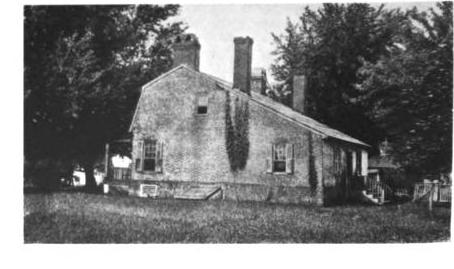Author – Donna R Causey
 COMEGYS HOUSE
COMEGYS HOUSE
Built 1708
Commanding a splendid view of the upper Chester River and the surrounding country, this rare example of Dutch architecture was the home of Dr. F. N. Sheppard and his wife. Mrs. Sheppard is a descendant of Alethia. daughter of the William Comegys who built the house and who was the second son of Cornelius Comegys, the emigrant.
Firmly established in Kent County, Maryland
By the time of the American Revolution in 1776 the Comegys were a family firmly established in Kent County, Maryland. At least seven Comegys men enrolled in military units during the Revolution, and as the young republic grew and prospered in the nineteenth century members of the family participated in the general expansion.
“The old Comegys House is an 18th century brick, gambrel roof house with an unusual rear addition covered with a catslide roof which is an extension of the upper slope of the gambrel.”
Woodwork and Wainscoting now missing
The woodwork and the wainscoting are very pretty and the great fireplaces suggest the many famous dinners served there to guests in the long ago. (The wainscoting has now disappeared) It was a charming old home and the lawn, originally terraced and hedged with boxwood, extended to the waters of the Chester River.
At the time the house was built there was a ferry, (“Collister’s Ferry”), across the Chester River at this point and just across the river in Queen Anne’s County William Crump took up a large tract of land he called “Crumpton.” It was for this property that the present village of Crumpton was named.
Well-established route
For years there had been a well-established route for travel from “Williamstadt,” (now Oxford), Talbot County, to Philadelphia and the Northern settlements. That route led past the old Wye Church in Talbot, through Queen Anne’s to Crumpton, over the Chester to Kent, across that county to Georgetown on the Sassafras, over the Sassafras and by way of Bohemia to “Head of Elk,” and so to Philadelphia.
The Emigrant
Cornelius Comegys, the emigrant, petitioned the Maryland Provincial Assembly in 1671 to be made a naturalized citizen. In his petition he states that he was born in “Lexmont, belonging to the states of Holland.” Millimety, his wife, was born in Barnevelt “under the domain of the said states,” and Cornelius, their oldest son, was born in Jamestown, Virginia in 1659.
Their other children, Elizabeth, William and Hannah, were born in Maryland. Cornelius Comegys emigrated to Virginia about 1600 and came to Maryland about 1663, receiving his first grant, 400 acres, called “Comegys Delight,” in that year.
Family Ties
Several thousand acres were later acquired by Comegy. Some of the tracts bore the following names: “The Grove,” “Vienna,” “Adventure,” “Fernando,” “Sewall” or “Utreck,” “Poplar Plains,” “Andover” and “Comegys’ Choice.” He was made a member of the Commissioners of Justice for Kent County in 1676 and was evidently a man of large interests.
Close family ties connected the descendants of Cornelius Comegys with the Wallis family, also with the Everett and Thomas families. To Nathaniel Everett was granted “Fair Harbor,” “Adventure” and “New Forest.” To Samuel Wallis, “Partnership,” “Conclusion” and “Boothbie’s Fortune” were granted. In 1659 William Thomas was granted “Kedgerton,” 1,000 acres, and “Mt. Hermon,” 89o acres.
Revolutionary War officer
Jesse Comegys, an officer in the Revolutionary War, son of William and Ann Cosden Comegys, married Mary Everett. They had three children, Cornelius, who was a lieutenant in the U. S. Army; Maria, who married Augustine Boyer; and Sarah Everett Comegys, who married John Wallis.
Their eldest son, Francis Ludolph Wallis, was commissioned August 6, 1846, captain of the Columbia Hussars, a company of cavalry attached to the Eighth Regimental Cavalry District, Maryland Militia.
Captain Wallis married Emily Thomas, daughter of William Thomas, of “Mt. Hermon.” Their only daughter, Mrs.Elizabeth Thomas Wallis Schutt, of Washington, inherited “Mt. Hermon” owned the propertyin 1916.
SOURCES
- Maryland’s Colonial Eastern Shore: Historical Sketches of Counties and of Some Notable Structures Swepson Earle, Percy G. Skirven Weathervane Books, 1916
- Maryland Historical Trust Form
See best-selling books by Donna R Causey
REVIEWS:
The exhilarating action & subplots keep the reader in constant anticipation. It is almost impossible to put the book down until completion,
Dr. Don P. Brandon, Retired Professor, Anderson University, Anderson, Indiana
This is the first book I have read that puts a personal touch to some seemingly real people in factual events.
Ladyhawk
Love books with strong women…this has one. Love early American history about ordinary people…even though they were not ‘ordinary’…it took courage to populate our country. This book is well researched and well written.
Julia Smith
A picture of love and history rolled into one. A step back in time that pulls you in and makes you a part of the family and their world.
Ken Flessas
Each book’s writing gets stronger, characters become real, the struggles and sorrows that laid the foundation for this country.
Addictedtobooks
Not only is the story entertaining, it opens the eastern shore of the early Virginia Colony to the reader as a picture book….I know this story will touch many peoples’ hearts.
B. Thomas
At the age of sixteen, Mary and her husband, whom she barely knows, are forced to escape the only home they’ve ever known and settle in the primitive 17th century world of America where they shape their family’s destiny for generations.
Inspired by actual people and historical events of colonial America, “The Kingdom of Accawmacke” is revealed and secrets about America’s history are discovered in this well-researched series. The story begins in 17th century England during the reign of Charles I and continues a family’s journey to the eastern shore of Virginia and Maryland.


